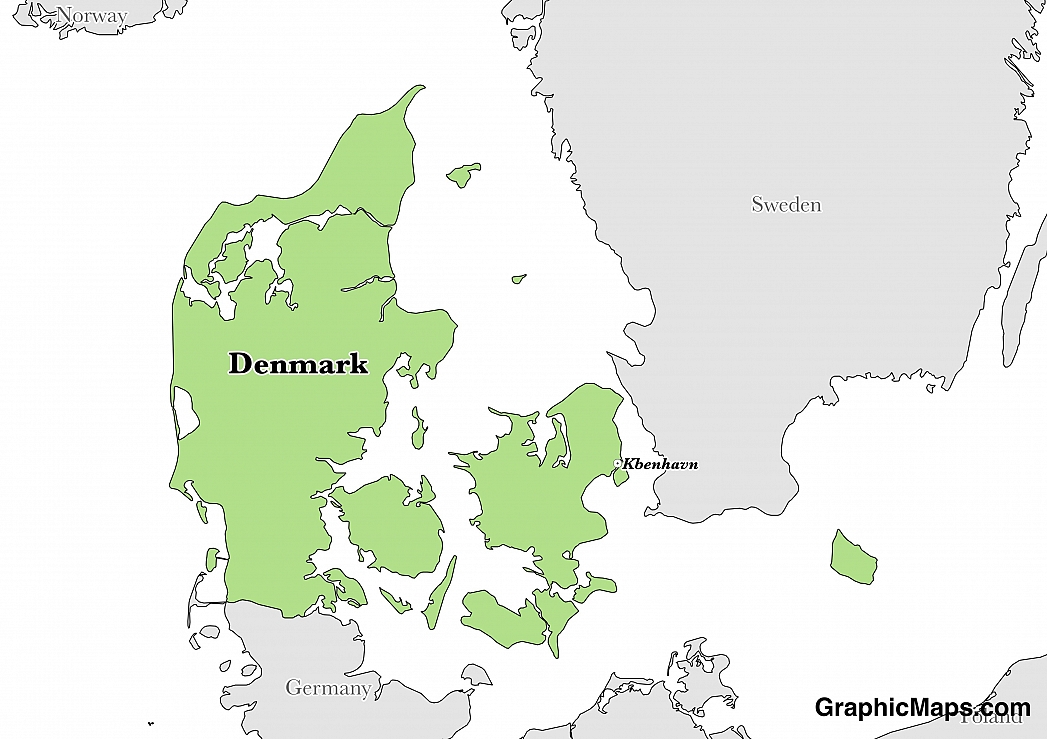Where is Denmark?
Located in Northern Europe, Denmark has a 140.00 km border with Germany. It has a 7,314.00 km coastline. Iceland, the United Kingdom, and Ireland all dispute Denmark's claim that the Faroe Island's continental shelf extends beyond 200 m.
The capital city of Denmark is Copenhagen. With a history going back more than 800 years, the city is one of the oldest in the world. It is situated on the largest island of Denmark, Zealand. Copenhagen is the most populous city in the region with a diverse group of people. Rich in cultural and architectural history, the city is popular among travellers.
Read more on Denmark's CapitalDenmark is a European country covering 43,094.00 km2 of which 1.53% is water and 42,434.00 km2 is land. The area excludes the Faroe Islands and Greenland but does include the island of Bornholm in the Baltic Sea and the rest of Denmark (the Jutland Peninsula, and the major islands of Sjaelland and Fyn). This makes it the 65th smallest country in the world and slightly less than twice the size of Massachusetts. Its geographic coordinates are 56 00 N, 10 00 E and Copenhagen is the capital city.
The word Denmark derives from the words "Dane" and "mark", the latter which refers to a forested area.
Its ISO code is DK.
Geography
Denmark has a mean elevation of 34 m above sea level.
It has a temperate climate with mild, windy winters and cool summers. Its terrain is low and flat, with some gently rolling plains.
Population
Denmark has a population of 5,593,785 making it the 115th largest in the world. The population centers of the country tend to be near coastal areas.
Danish is the official language. The largest ethnic group is Scandinavian. The majority of the population is Evangelical Lutheran.
The official language of Denmark is Danish. Out of the 5.7 million people in the city, over 98% speak the language. It is mainly used for official purposes and the language of instruction in schools. Danish has 29 alphabetical letters and contains differing dialects. Some overseas territories of Denmark have their official languages. Such regions include Greenland and Faroe where Greenlandic and Faroese languages are spoken. English is used as a second language by a majority of Danes, and about 86% of the population are fluent in the language. It is mandatory among the Danish people and is often taught in primary schools. Other minority languages in Denmark include German, Swedish, and Danish sign language. Danish stands out from the other two Scandinavian languages mainly because written words appear different from verbalized words.
Read more on Denmark's LanguagesThe dialing code for the country is 45.
Government
Denmark is an independent country. It becme a parliamentary constitutional monarchy in 1849. Its constitution was last ratified in 1849.
Denmark is a constitutional Monarchy that was established in 1849 to be governed by a monarch and a representative parliament. The monarch, who has been Queen Margrethe II since 1973, appoints a prime minister who heads the cabinet. Copenhagen is the government and parliamentary seat of Denmark. The Kingdom has four–year representative elections, which are based on a proportional representation model.
Read more on Denmark's GovernmentEconomy
Factoring in Purchasing Power Parity, Denmark's GDP is $265,000,000,000.00 (USD) with $46,600.00 (USD) per capita. This makes it the 60th largest economy and its citizens the 32nd richest in the world. The currency of Denmark is the Krone (DKK).
Its major export partners are Germany, Sweden, Norway, and the United Kingdom. Its main exports are machinery and instruments, meat and meat products, and dairy products. Its major import partners are Germany, Sweden, and the Netherlands. Its major imports include machinery and equipment, raw materials and semimanufactures for industry, and chemicals.
Flag
The current flag of Denmark is known as the Dannebrog or the red flag. It was adopted 1219 when the Danish King Valdemar II won the battle of Estonia. Regions and kings have used the Danish flag as banners or flags. For example, the oldest version dates back to 1370 when it was used in the Gerle Armorial. Today, the Dannebrog is the oldest flag in Europe, with the red representing strength and bravery, and the white cross representing peace and honesty.
Read more on Denmark's FlagThis page was last modified on January 17th, 2018
More on Graphicmaps

Published on 2019-11-06
What is a Trade Embargo?

Published on 2019-11-04
Which Two Countries Used to Have the Same Flag?

Published on 2019-09-16
What Is the Only Two-Sided State Flag?

Published on 2019-09-16
Which Country Flag Looks Like the Texas Flag?

Published on 2019-08-29
Flags That Resemble the US Flag

Published on 2019-08-20
